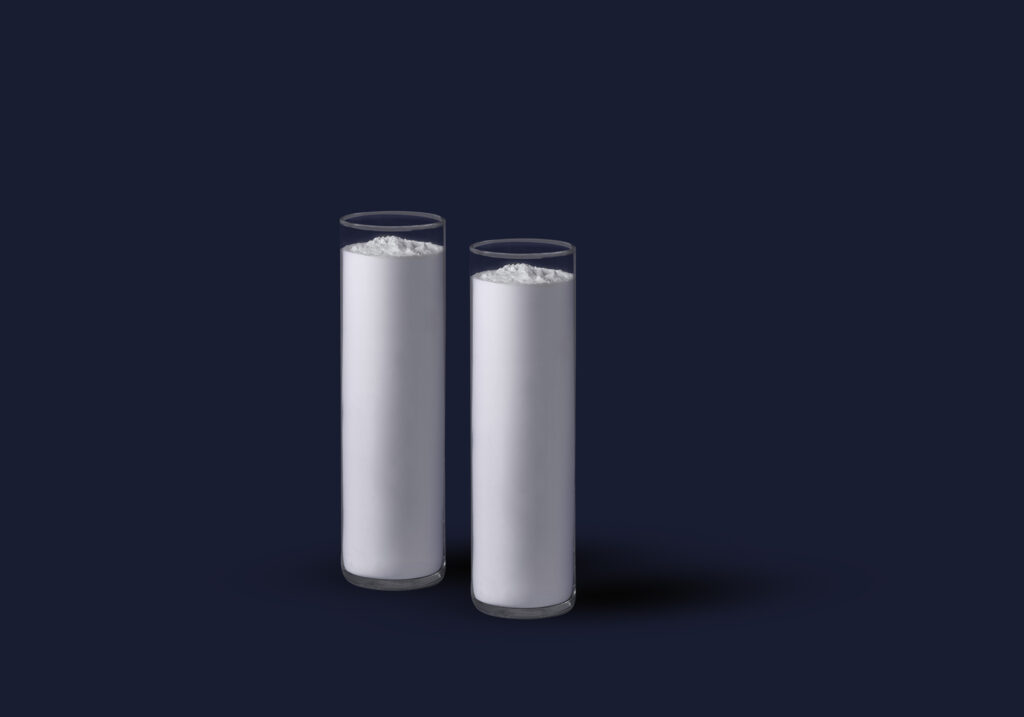Products
Quartzene
Quartzene is the brand name of a novel platform of synthetic silica powder materials designed to boost the functional performance of your product.
Quartzene is in most applications used as a functional additive. As manufacturer of, for instance, paint, plaster, building panels or sealants, you can improve the sustainable performance of your products by adding Quartzene. The main purpose here is to improve insulation, reduce material consumption, reduce weight, replace plastic and increase safety – often Quartzene contributes to a combination of these in one and the same solution.
Optimized for your needs
Quartzene is offered as hydrophilic or hydrophobic grades, and the selection of suitable grade depends on the composition and manufacturing process of your product and the conditions prevailing during the stage of use.
All materials are open-porous and hence allows for exchange with surrounding conditions. The hydrophilic grades are chemically inert and can withstand very high operating temperatures without losing their performance. The hydrophobic treatment is resistant to 275°C, but the structure and the other properties will remain far beyond that.
Hydrophilic grades
Z1
Small particles with a wide range of use
Quartzene Z1 is a fine-grained pure silica powder with particle size ranging from 1-15 µm. It can be used as a functional filler or additive in your product to boost or add new functionality. By adding Quartzene Z1 you will significantly improve the thermal insulation and at the same time reduce the weight and increase the bulk. Quartzene Z1 is completely inorganic and incombustible and performs extremely well as a fire retardancy additive. Here it will extend the time to ignition and reduce heat and smoke generation. Quartzene Z1 can also be used as an active material to absorb or release specific compounds. Thanks to its polar character it is easy to mix into various waterbased products but is also compatible with solvent-borne and solvent-free silicone, PUR, PIR, epoxy and similar resins. Quartzene Z1 can be used in a wide range of products such as coatings, plasters, self-levelling floors, building panels etc. With its small particle size, Z1 will present a smooth surface after incorporation.Z2
Larger particles for less viscosity
Quartzene Z2 is chemically identical to Z1 but is engineered to a larger particle size ranging from 1-70 µm. Quartzene Z2 can be used in similar products and applications as Z1, but the larger particles have less viscosity impact in dispersions and thus allows for higher charging levels compared to Z1. Another benefit is reduced dusting. Quartzene Z2 in thin coatings will present a fine texture and a matting effect.Hydrophobic grades
Quartzene Z1H1 and Z2H1 grades are ideal for insulation solutions where space and weight considerations are critical, such as retrofit building insulation and automotive insulation, particularly for the strongly growing electrical vehicle segment.
Z1H1
1-12 µm
Quartzene Z1H1 is the hydrophobic countertype of Z1 where a secondary chemical process converts the hydrophilic material to a robust and durable hydrophobic character. It is the finest hydrophobic grade with a particle size distribution between 1-12 µm. The water repellent nature makes it suitable for products and applications where moisture absorption cannot be accepted. Even if it is strongly hydrophobic, it can, for instance, be incorporated into a range of different waterborne acrylics, polyurethanes, and vinyl-acetates to create highly insulating coatings and plasters. It can also be used in building panels, sealants and similar products. The low density will bring down the weight of your product and can replace fossil plastic.Z2H1
1-100 µm
Quartzene Z2H1 is the hydrophobic countertype of Z2. It has a particle size range between 1-100 µm. Due to the increased particle size, Z2H1 will have less viscosity impact in dispersions than Z1H1 and can thus be added in higher amounts.
Chemical composition
Key properties
| Property | Unit | Method | Z1 | Z2 | Z1H1 | Z2H1 |
|---|---|---|---|---|---|---|
| Surface character | n/a | Internal | Hydrophilic | Hydrophilic | Hydrophobic | Hydrophobic |
| Density | kg/l | DIN ISO 787 part 11 | 0.05-0.10 | 0.10-0.15 | 0.10-0.15 | 0.17-0.22 |
| Thermal conductivity | mW/m·K | Hot Disk TPS ISO 22007-2:2022 | 25-31 | 28-33 | 28-31 | 28-33 |
| Particle size range | µm | ISO 13320:2020 | 1-15 | 1-70 | 1-20 | 1-100 |
| Pore size | Nm | ISO 15901-2:2022 | ~ 6 | ~ 7 | ~ 6 | ~ 7 |
| BET surface area | m²/g | ISO 9277:2022 | 200-600 | 200-600 | 120-220 | 100-300 |
Documents
Quartzene product data sheet
SeaQare®
Want to know more?
Contact us or one of our distributors for assistance in finding the right product for you.
